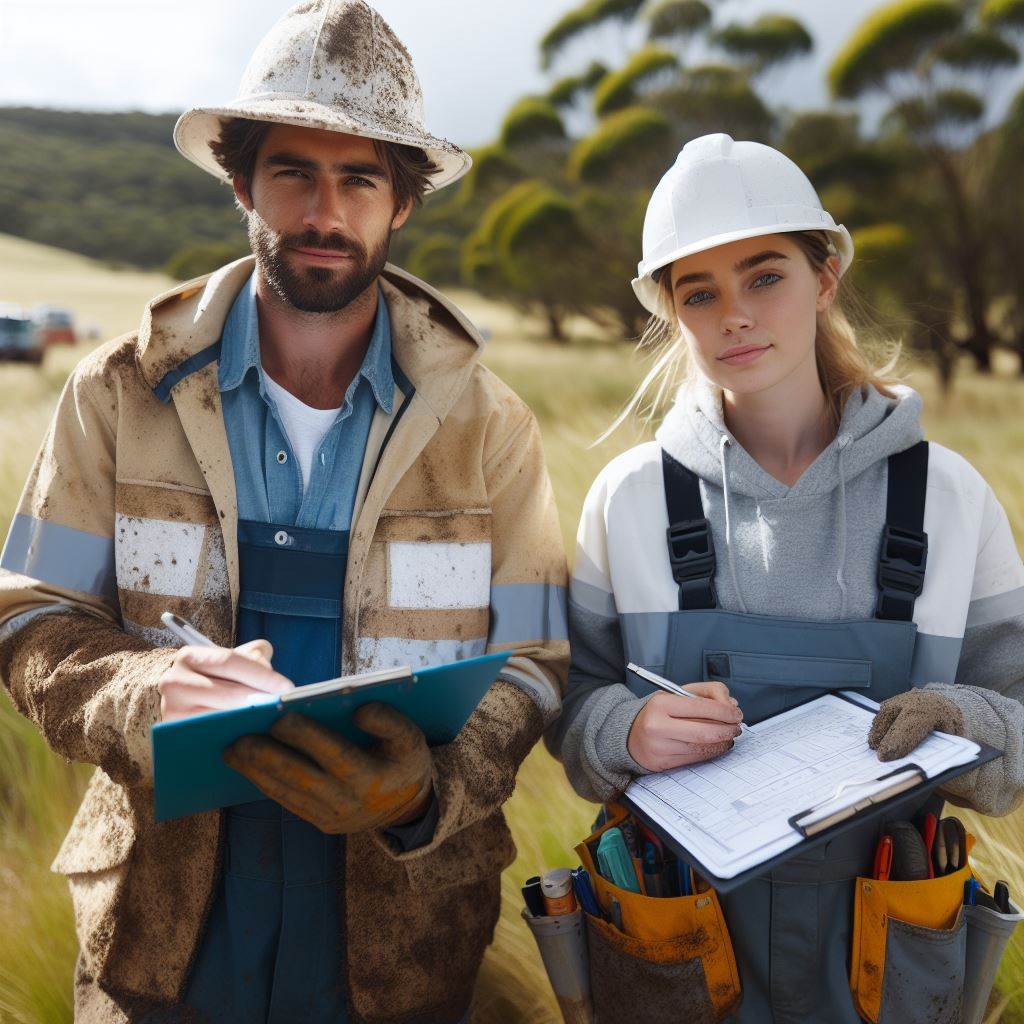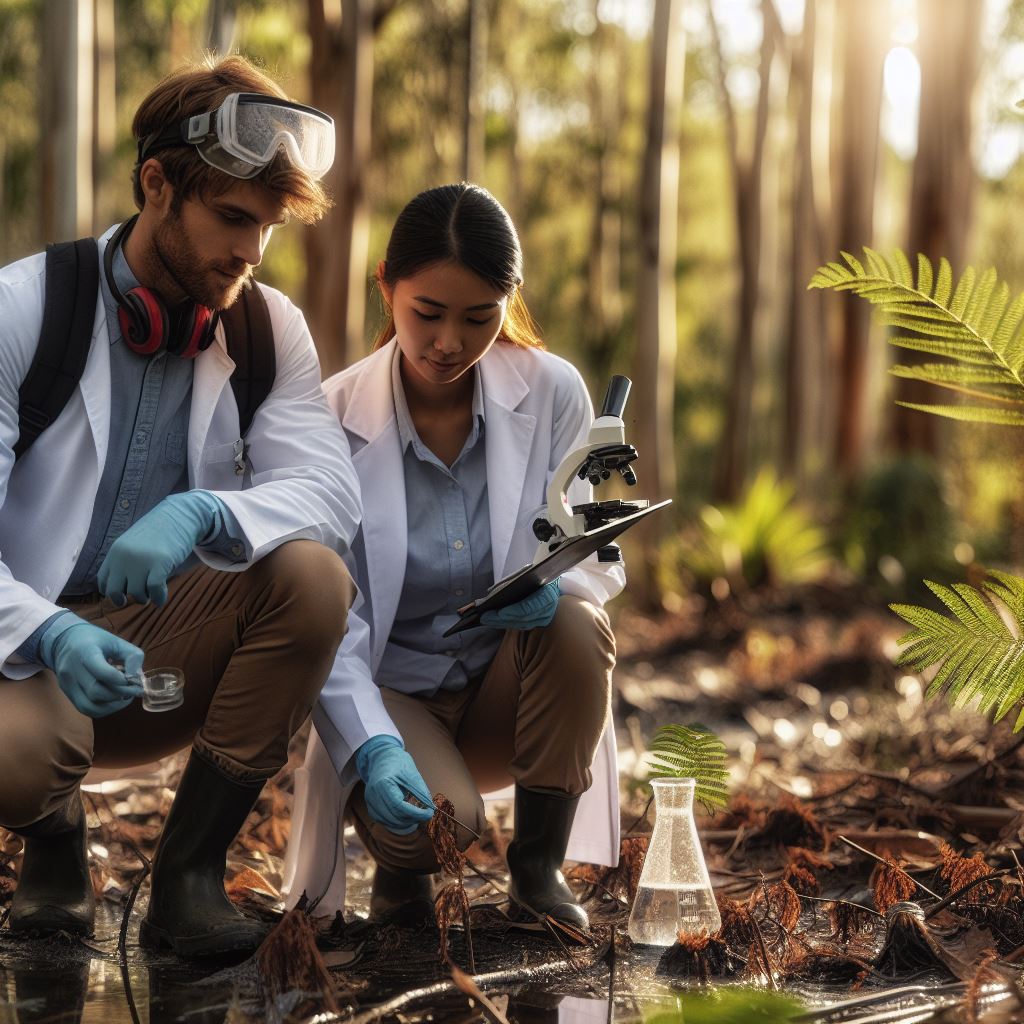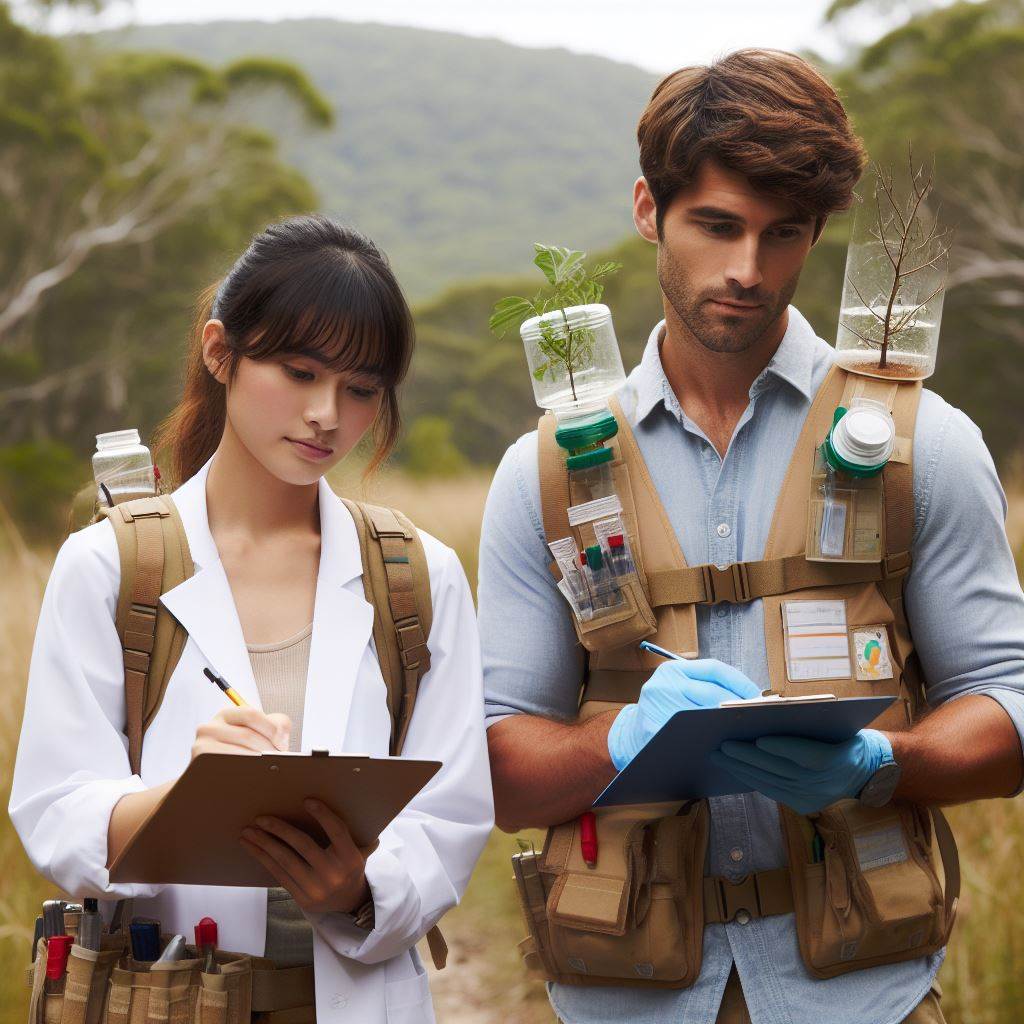Introduction
Embarking on fieldwork, Aussie environmental scientists encounter challenges and discoveries that shape their unique narratives and experiences.
Fieldwork is integral to environmental science, providing hands-on opportunities to study ecosystems, collect data, and address environmental issues.
From remote landscapes to urban environments, Aussie environmental scientists delve into diverse ecosystems, applying their expertise to conservation and restoration efforts.
These field experiences not only contribute to scientific knowledge but also foster a deep appreciation for Australia’s rich biodiversity.
In this section, we explore the captivating tales and insights shared by Aussie environmental scientists during their fieldwork adventures.
Join us on a journey into the heart of Australia’s diverse landscapes and witness the environmental challenges and triumphs faced by these dedicated scientists.
From monitoring wildlife to studying plant adaptations, fieldwork offers a dynamic platform for environmental scientists to unravel the complexities of nature.
The unpredictability of the field poses both excitement and hurdles, pushing scientists to adapt and innovate in real-time scenarios.
Aussie environmental scientists navigate the complexities of fieldwork, employing cutting-edge technologies and traditional ecological methods to gather comprehensive data.
As we delve into their stories, we gain a deeper understanding of the dedication and passion driving environmental research in Australia.
Get ready to explore the challenges, triumphs, and unexpected moments that shape the fieldwork experiences of Aussie environmental scientists.
Fieldwork Experience 1: Rainforest Research
Description of the specific research project conducted in a rainforest
In the heart of the lush rainforest, our team embarked on a unique and thrilling research project. With determination and scientific curiosity, we set out to unravel the mysteries hidden within this ancient ecosystem.
Challenges faced by the scientists in terms of weather conditions, logistics, and data collection
The rainforest posed a multitude of challenges that tested our skills and resilience. The ever-changing weather conditions added an element of unpredictability to our fieldwork. Rain, heat, and humidity became our constant companions, making every step a challenge.
Furthermore, logistics proved to be a demanding aspect of our research. Remote locations within the rainforest meant that reaching the designated areas required us to navigate through thick foliage, treacherous terrains, and seemingly impenetrable vegetation.
Data collection, amidst these challenging circumstances, was no easy feat. Countless hours were spent meticulously gathering samples, conducting experiments, and recording observations. The rainforest demanded our utmost attention and precision, leaving no room for mistakes.
Exciting discoveries and insights gained from the research
However, amidst these difficulties, there were also exciting discoveries that fueled our passion for environmental science. The sheer diversity of flora and fauna left us awe-struck.
Rare species of plants, vibrant insects, and elusive birds revealed themselves, making us realize the true wonders of nature.
One particular discovery that left a lasting impact was the identification of a new species of orchids. With delicate petals in hues of pink and purple, this species had remained hidden from scientific knowledge until now.
It was a testament to the importance of preserving these habitats and protecting their unique inhabitants.
Our rainforest research also provided us with invaluable insights into the ecosystem’s fragile balance. We witnessed firsthand the interconnectedness of various species and how human activities can disrupt this delicate equilibrium.
It reinforced our commitment to championing conservation efforts and promoting sustainable practices.
Personal anecdotes and reflections from the scientists involved
Personal anecdotes and reflections from our time in the rainforest filled our days and nights. Nights were spent huddled around campfires, sharing stories of encounters with rare creatures and navigating through treacherous terrain.
These conversations not only strengthened our bond as a team but also deepened our appreciation for the natural world.
Generally, our rainforest research project was a journey of exhilarating highs and arduous challenges. It taught us the importance of perseverance, adaptability, and humility in the face of nature’s grandeur.
We left the rainforest forever changed, with a renewed sense of purpose and a commitment to protect these extraordinary environments for generations to come.
Read: Innovative Chemistry Startups in Australia
Fieldwork Experience 2: Coastal Erosion Studies
Overview of the study conducted on coastal erosion and its impact on the environment
During our fieldwork on coastal erosion, we aimed to understand the impact of this natural process on the environment.
We encountered numerous difficulties throughout our study, including accessing remote areas, dealing with harsh weather conditions, and documenting erosion patterns accurately.
As we embarked on our journey, we quickly realized that reaching some of the remote coastal areas would be our biggest challenge. These areas were inaccessible by road, and we had to rely on boats or even hike through dense forests to reach our desired locations.
Difficulties encountered during fieldwork
Furthermore, the unpredictable and often harsh weather conditions made our fieldwork even more challenging. We had to constantly adapt our plans according to sudden storms, heavy rainfalls, or strong winds. It was essential to prioritize our safety and well-being above all else.
Once on site, we faced the task of accurately documenting erosion patterns.
Gathering data required great attention to detail. We spent hours carefully measuring the extent of erosion, taking photographs, and making meticulous sketches. These records would be crucial for our analysis.
Your Personalized Career Strategy
Unlock your potential with tailored career consulting. Get clear, actionable steps designed for your success. Start now!
Get StartedKey findings and implications for coastal management and conservation
The key findings from our study shed light on the severe consequences of coastal erosion. Not only did we observe the loss of significant amounts of land, but we also witnessed the destruction of precious habitats for numerous plant and animal species.
These findings have important implications for coastal management and conservation. It is evident that appropriate measures need to be taken to mitigate further erosion.
This includes the implementation of coastline protection strategies such as artificial reefs, beach nourishment, or seawalls.
Coastal communities should also be involved in the decision-making process to ensure sustainable solutions that consider local interests and traditions.
By raising awareness about the importance of coastal conservation, we can strive towards a more harmonious and resilient coastal environment.
Insights and memorable moments shared by the scientists during their fieldwork
Despite the challenges we faced, our fieldwork experience was filled with insightful moments and memorable encounters. One of the most remarkable moments was observing a nesting sea turtle on a beach that was slowly eroding away.
Witnessing this vulnerable creature in its natural habitat made us realize the urgent need for our research. These experiences not only encouraged us to work harder but also instilled a deep sense of responsibility towards protecting these fragile ecosystems.
In general, our fieldwork on coastal erosion provided us with a comprehensive understanding of the impact it has on the environment.
By overcoming various difficulties, we were able to gather valuable data that will contribute to the development of effective coastal management and conservation strategies.
Through our research, we hope to raise awareness about the importance of preserving and protecting our coastlines, ensuring a sustainable future for both the environment and the communities that depend on it.
Read: Must-Attend Chemistry Conferences in Aus
Gain More Insights: Chemistry Internships: A Guide for Aussies
Fieldwork Experience 3: Marine Biodiversity Surveys
Explanation of the purpose and significance of studying marine biodiversity
Studying marine biodiversity is crucial in understanding and protecting our fragile ocean ecosystems. By examining the variety of species and their interactions, scientists can assess the health of the marine environment and identify conservation priorities.
Challenges faced by scientists while conducting underwater research
Conducting underwater research poses numerous challenges for scientists. Limited visibility due to murky waters or low light conditions can make it difficult to accurately observe and record marine life.
Additionally, the equipment used for underwater surveys must be carefully selected and maintained to ensure accurate data collection.
Noteworthy discoveries, including new species, coral bleaching observations, and the importance of preserving marine habitats
Safety is of utmost importance when working in the marine environment. Scientists must be trained in diving techniques and follow safety protocols to minimize risks.
They have to be aware of their surroundings and potential hazards such as strong currents or encounters with dangerous marine creatures.
Despite these challenges, marine biodiversity surveys have led to noteworthy discoveries. Scientists have identified new species previously unknown to science, highlighting the vastness and diversity of the marine world.
These discoveries emphasize the importance of continued exploration and protection of marine habitats.
One significant observation made during these surveys is the occurrence of coral bleaching. Rising water temperatures, pollution, and ocean acidification are causing stress to coral reefs, leading to their bleaching and eventual death.
These observations contribute to our understanding of climate change impacts on marine ecosystems.
Stand Out with a Resume That Gets Results
Your career is worth more than a generic template. Let us craft a resume and cover letter that showcase your unique strengths and help you secure that dream job.
Get HiredPreserving marine habitats is crucial for maintaining biodiversity and ecosystem services. Marine protected areas, such as national parks, provide safe havens for marine life and promote sustainable fishing practices.
By protecting these habitats, we can safeguard the delicate balance of marine ecosystems.
Anecdotes and personal experiences shared by the scientists while exploring the underwater world
Many scientists have memorable anecdotes and personal experiences while exploring the underwater world. Dr. Sarah, a marine biologist, recalls an encounter with a playful seal during a research expedition.
The seal swam alongside her, seemingly curious about the divers, creating a magical moment she will never forget.
Dr. Jake, an underwater photographer, shares his excitement when he discovered a rare species of seahorse hiding among the corals. His photograph of the tiny creature became an icon for conservation efforts, raising awareness about the fragile beauty of marine life.
These personal experiences remind us of the awe-inspiring wonders that exist beneath the surface of our oceans. They ignite a passion for understanding and protecting our marine environments, pushing scientists to continue their fieldwork and share their knowledge.
Marine biodiversity surveys play a crucial role in understanding and protecting our oceans. The challenges faced by scientists during underwater research highlight the importance of careful planning, equipment maintenance, and safety precautions.
Noteworthy discoveries, including new species and observations of coral bleaching, emphasize the need for continued exploration and preservation of marine habitats.
The personal experiences and anecdotes shared by scientists inspire awe and awareness of the importance of our oceans.
By studying marine biodiversity and sharing their findings, Aussie environmental scientists contribute to the global effort to conserve and sustainably manage our precious marine ecosystems.
Read: Australian Women in Chemistry: Trailblazers

Fieldwork Experience 4: Wildlife Tracking and Conservation
Overview of the research focused on tracking and conserving wildlife species
At the heart of wildlife research lies the crucial task of tracking and conserving various species.
The challenges faced in this line of work are as diverse as the animals themselves; navigating complex terrains, decoding unpredictable behavior, and embracing the virtue of patience.
Difficulties encountered while tracking animals in their natural habitats
Tracking animals in their natural habitats is far from a walk in the park. Researchers often find themselves deep within jungles or trekking through treacherous mountains, constantly adapting to ever-changing landscapes.
The terrain alone can pose significant challenges, with its dense foliage and steep slopes. Every step taken calls for careful consideration and unwavering focus.
Patience, a virtue often overlooked, becomes an indispensable ally when tracking wildlife. Animals do not follow a predetermined script; they move according to their own instincts and behaviors.
Trying to predict their next move is like attempting to read a captivating novel with missing sections. Wildlife researchers must learn to be patient observers, waiting tirelessly for opportunities to study and understand the creatures they seek to protect.
Success stories of wildlife conservation efforts and the impact of research findings on conservation strategies
One success story that warrants recognition is the conservation efforts for the critically endangered orangutans in Borneo. With their numbers dwindling due to habitat destruction, scientists embarked on an ambitious mission to track and protect these magnificent creatures.
By closely monitoring their movements and understanding their needs, researchers were able to propose effective conservation measures that have led to a steady increase in the orangutan population.
Another triumph lies in the conservation strategies employed for African elephants. These majestic giants face threats from poaching and habitat loss.
Scientists played a pivotal role in developing tracking techniques to monitor elephant movements and migration patterns.
By gathering crucial data on their behavior and habitat utilization, researchers collaborated with local authorities to implement measures to safeguard these iconic animals.
Fascinating encounters and encounters with animals shared by the scientists
While success stories pave the way towards conservation, there is no denying the myriad of fascinating encounters experienced by wildlife researchers. One scientist recalls the awe-inspiring moment when they stumbled upon a family of lions during their tracking expedition.
As they cautiously observed the regal creatures from a safe distance, a newfound respect and admiration for these animals emerged.
Transform Your LinkedIn for Maximum Impact
Elevate your professional brand with a LinkedIn profile that attracts recruiters, showcases your expertise, and maximizes opportunities. Stand out in your industry with a profile built for success.
Boost ProfileAnother captivating encounter came in the form of a playful dolphin pod off the coast of Australia. Researchers conducting marine mammal studies were enthralled by the dolphins’ acrobatic displays and their ability to create an atmosphere of pure joy.
Such encounters serve as a reminder of the beauty and diversity that exists within our natural world.
Wildlife tracking and conservation form the backbone of numerous research initiatives. They allow scientists to enlighten the world about the habits, needs, and vulnerabilities of various species.
The impact of these findings extends far beyond the research community, shaping conservation strategies and policies on a global scale.
So, the next time you spot a magnificent creature in its natural habitat, remember the dedication and perseverance of the scientists who work tirelessly to protect and preserve wildlife.
Read: The Future of Green Chemistry in Australia
Conclusion
In this blog section, we have delved into the captivating fieldwork tales shared by Aussie enviro scientists. Each story has not only provided fascinating insights into the natural world but has also highlighted the significance of fieldwork in environmental science.
The diverse range of experiences recounted by these scientists emphasizes the unique contribution and relevance of fieldwork in understanding and conserving our environment.
Through their hands-on research, these scientists have been able to gain a deeper understanding of ecosystems and their intricate workings.
For aspiring scientists, the stories shared by seasoned researchers offer a wealth of knowledge and inspiration. They serve as a reminder of the importance of pursuing fieldwork and the unparalleled learning opportunities it presents.
In this rapidly changing world, where environmental challenges seem to mount by the day, the contributions of Aussie environmental scientists cannot be overstated.
Their commitment to preserving and protecting our environment has helped shape policies, promote awareness, and drive positive change.
As we conclude this section, it is essential to express our deepest appreciation for the invaluable work done by these scientists. Their passion, dedication, and unwavering efforts serve as a beacon of hope in safeguarding the natural world for generations to come.
Let us take inspiration from their tales and continue to explore the wonders of fieldwork, uncovering the secrets of our planet, and working towards a sustainable future.




